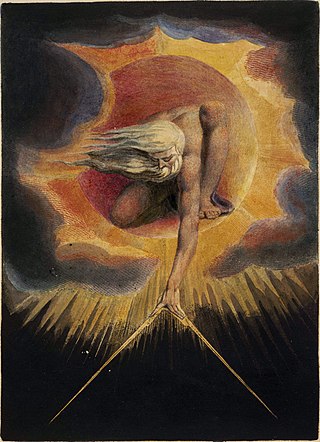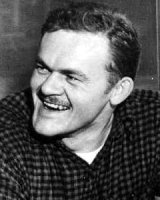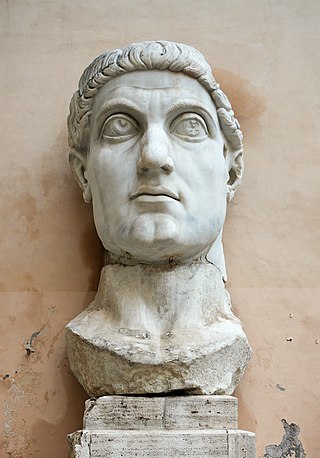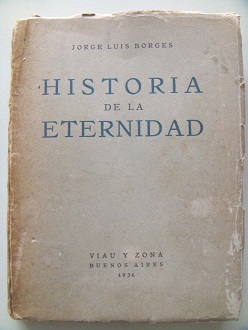
Ancient of Days is a name for God in the Book of Daniel.

Eternity, in common parlance, is an infinite amount of time that never ends or the quality, condition or fact of being everlasting or eternal. Classical philosophy, however, defines eternity as what is timeless or exists outside time, whereas sempiternity corresponds to infinite duration.

The Celtic cross is a form of Christian cross featuring a nimbus or ring that emerged in Ireland, France and Great Britain in the Early Middle Ages. A type of ringed cross, it became widespread through its use in the stone high crosses erected across the islands, especially in regions evangelised by Irish missionaries, from the ninth through the 12th centuries.

James Ramon Jones was an American novelist renowned for his explorations of World War II and its aftermath. He won the 1952 National Book Award for his debut novel, From Here to Eternity, which was adapted for film a year later and made into a television series a generation later.

From Her to Eternity is the debut studio album by the Australian rock band Nick Cave and the Bad Seeds, released in May 1984 by Mute Records. Produced by Flood and the band itself, the album's title is a pun on James Jones' debut novel, From Here to Eternity (1951), and its subsequent 1953 film adaptation.

Your Funeral... My Trial is the fourth studio album by the Australian rock band Nick Cave and the Bad Seeds, released on 3 November 1986 by Mute Records. The album was originally released as a double extended play (EP), while also issued on CD with a different running order and the additional track "Scum". During this period in his life, Cave was steeped in heroin addiction, perhaps evidenced by the melancholy, desperate mood of this album. This was the final Bad Seeds album to feature Barry Adamson until he returned for Push the Sky Away (2013).

Alpha and omega are the first and last letters of the Greek alphabet, and a title of Christ and God in the Book of Revelation. This pair of letters is used as a Christian symbol, and is often combined with the Cross, Chi Rho or other Christian symbols.

The word Eternity was a graffito tag recorded over an approximate 35-year period from 1932 to 1967, written numerous times in chalk in the streets of Sydney, Australia. The word had been written by Arthur Stace, an illiterate former soldier, petty criminal and alcoholic who became a devout Christian in the late 1940s.
Walter Ralston Martin was an American Baptist Christian minister and author who founded the Christian Research Institute in 1960 as a parachurch ministry specializing as a clearing-house of information in both general Christian apologetics and in countercult apologetics. As the author of the influential The Kingdom of the Cults (1965), he has been dubbed by the conservative Christian columnist Michael J. McManus, the "godfather of the anti-cult movement".

Andrew Michael Graham-Dixon is a British art historian, art critic, author and broadcaster. He is best known for his work as chief art critic at The Independent and The Telegraph newspapers, and for presenting numerous art documentaries for the BBC, as well as five series of Italy Unpacked - in which he explored the culture and cuisine of Italy with chef Giorgio Locatelli. Graham-Dixon currently lectures all over the world; hosts private art tours; writes for various journals; creates online content for his website and YouTube channel, and creates video and written content for Sotheby's. He is writing a book about the life and work of Vermeer, which is due to be published in 2025.

Aircel Comics was a comic book publisher founded by Barry Blair, in Ottawa, Ontario in 1985. In 1988, it merged with American publisher Eternity Comics, itself an imprint of Malibu Comics, and in the late 1980s was taken over by Malibu before ceasing publication in 1994. It was best known as the original publisher of The Men in Black, a comic book which was later adapted into a media franchise.

Sorrowing Old Man (At Eternity's Gate) is an oil painting by Vincent van Gogh that he made in 1890 in Saint-Rémy de Provence based on an early lithograph. The painting was completed in early May at a time when he was convalescing from a severe relapse in his health some two months before his death, which is generally accepted as a suicide.

The Colossus of Constantine was a many times life-size acrolithic early-4th-century statue depicting the Roman emperor Constantine the Great, commissioned by himself, which originally occupied the west apse of the Basilica of Maxentius on the Via Sacra, near the Forum Romanum in Rome. Surviving portions of the Colossus now reside in the courtyard of the Palazzo dei Conservatori, now part of the Capitoline Museums, on the Capitoline Hill, above the west end of the Forum.
Eternity is an Australian Christian media service that produces a bi-annual magazine and a daily online publication. Published by Bible Society Australia, Eternity is interdenominational, and is not affiliated with any particular church.

Doctor Who: The Eternity Clock is a 2012 action-adventure video game based upon the BBC television series Doctor Who. It was intended to be the first of a series, but it was announced in 2013 that the sequels have been put on hold.
Collage film is a style of film created by juxtaposing found footage from disparate sources. The term has also been applied to the physical collaging of materials onto film stock.

The Armenian eternity sign or Arevakhach is an ancient Armenian national symbol and a symbol of the national identity of the Armenian people. It is one of the most common symbols in Armenian architecture, carved on khachkars and on walls of churches.

From Here to Eternity is a musical with music and lyrics by Stuart Brayson and Tim Rice and a book by Bill Oakes. Based on the 1951 novel of the same name by James Jones, the musical made its West End and world premiere in 2013, at the Shaftesbury Theatre, London.

Historia de la eternidad is a book of essays published by Argentine author Jorge Luis Borges, in 1936.

At Eternity's Gate is a 2018 biographical drama film about the final years of painter Vincent van Gogh's life, including dramatizing the theory that van Gogh's death was caused by manslaughter rather than suicide.

















